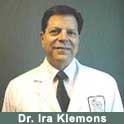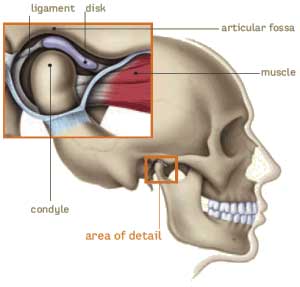by Ira M. Klemons, D.D.S., Ph.D.
 Editor’s Note: Dr. Ira Klemons is the founder and past President of the American Academy of Cranio-facial Pain. He is currently director of the Center for Head and Facial Pain in South Amboy, New Jersey. His practice is devoted to head and facial pain and temporo-mandibular joint dysfunction.
Editor’s Note: Dr. Ira Klemons is the founder and past President of the American Academy of Cranio-facial Pain. He is currently director of the Center for Head and Facial Pain in South Amboy, New Jersey. His practice is devoted to head and facial pain and temporo-mandibular joint dysfunction.
The condition commonly referred to as “TMD” – temporomandibular joint disorder – is a complex dysfunction of muscles, ligaments, and joints in the head, face, and neck. (The temporomandibular joint, or TMJ, is the joint in front of the ear which allows us to speak, chew, swallow, kiss, smile, and exhibit normal facial expressions.) TMD is typically caused by injuries that result from falls, automobile accidents, trauma at birth, etc. It is very common for the onset of symptoms to be delayed for months or years. The delay of onset occurs, in part, because these tissues progressively degenerate.
Up to half the patients who have TMJ dysfunction have tinnitus as one of their symptoms, and in these patients, success rates in eliminating these sounds approach 90%. Recent research has found that TMD therapy improves tinnitus in 46-96% of patients who have TMD and coexisting tinnitus. A survey of patients taken two years after TMD therapy suggests that improvement is sustained over time.
The diagnosis of TMD requires evaluation by a dentist or physician with advanced training and experience in treating head and facial pain. Diagnosis begins by taking a detailed history of the patient’s (sometimes extensive) list of complaints. Symptoms can include headaches; pain in the face, eye, neck, or ear; blurred vision that comes and goes; hearing loss that comes and goes; frequent sore throats; dizziness; ringing in the ears; pressure or blocked sensation in the ears; difficulty swallowing; burning tongue; and tingling or numb sensations of the arms and hands. A physical examination of the muscles of the head, face, neck, and shoulders is done using manual palpation to rule out “trigger points” and muscle spasms that can transfer pain to other areas. Range of motion tests, x-rays, sonograms, and painless EMG’s can also help in reaching an accurate diagnosis.

Treatment commonly employs painless procedures which help stimulate muscles and joints to function normally, decrease spasm, remove toxic waste products, and increase blood flow and nutrition to the affected areas. Therapies such as low current electrical stimulation to reduce muscle spasm and stimulate healing, ultrasound for deep tissue heating, hydrocollator for moist heat, and cryotherapy (cold therapy) are used with a variety of removable orthopedic appliances aimed to correct the position of the condyle, or “ball”, of the lower jaw within its socket. In addition, joint mobilization procedures, physical manipulation, and other procedures might be employed. Eighty four percent of our last 1200 TMD patients who also had tinnitus reported that their ear sounds were “gone” or “almost gone” after treatment.
Treatment time and costs vary according to the extent of dysfunction, the simultaneous presence of related problems such as neck injury and thyroid disorders, patient compliance, and the patient’s age. Unfortunately, for reasons not yet explained, we have found a decreased success rate for elimination of tinnitus in patients over 60 years of age.
Many patients are given only home care instructions at a single visit, while others require an average of 4-6 months of care. Still others require much lengthier treatment and, in a small number of cases, even surgery. Approximately 1% of our patients require TMJ surgery and approximately 3% require radiofrequency thermoneurolysis – a surgical procedure that uses high frequency electrical energy to modify or eliminate pain impulses from injured structures. This technique in particular offers enormous promise for eliminating pain and tinnitus where other conservative procedures have failed to bring relief.
Wright and Bifano cite a study in which the relationship between tinnitus and TMD therapy resulted in the following: of 276 TMD patients who were evaluated, 101 reported co-existing tinnitus. Ninety three of those agreed to participate in the study. Of the 93 subjects who were treated for TMD, 52 said that their tinnitus had resolved, 28 reported experiencing significant improvement, and 13 reported minimal or no improvement. No one reported experiencing a worsening of the condition. It’s been noted that patients who have tinnitus without any other symptoms are relatively unlikely to experience improvement with treatment of this type.
Over the last few decades, we have come a long way in diagnosing and treating TMJ disorders and the accompanying symptoms such as tinnitus. No doubt future research will provide greater knowledge regarding the relationship between tinnitus and temporomandibular joint dysfunction and consequently even higher success rates than are available at the present time.
For more information on TMJ go to http://www.tmj.org.
To find a TMJ specialist in your area go to: American Academy of Craniofacial Pain.
References
1. Wright, F., and S. Bifano: Tinnitus Improvement Through TMD Therapy, JADA, vol. 128, pp. 1424-9, Oct. 1997.
2. Gelb, H., M. Gelb, and M. Wagner: The Relationship of Tinnitus to Craniocervical Mandibular Disorders, Journal of Craniomandibular Practice, vol. 15, no. 2, pp. 136-142, April 1997.
Get Free Shipping!
Order now and get free shipping on either the Tinnitus Starter Kit or Combo Pack. Try the doctor recommended products with clinically proven ingredients for tinnitus. No coupon code required.

